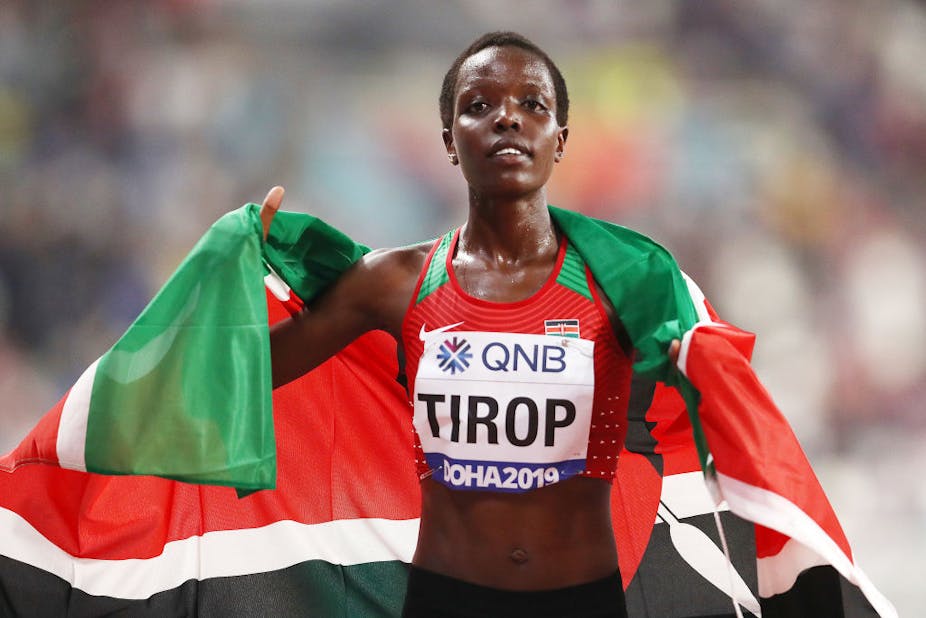Kenyan world record holder Agnes Tirop was found stabbed to death at her home in the western town of Iten last week. The fact that the police arrested her husband in connection with the death has brought the subject of domestic violence to the fore in Kenya. Population and reproductive health researcher Yohannes Dibaba Wado shares his insights into how widespread it is and what must be done to address it.
Is domestic violence widespread in Kenya?
Domestic violence, also called intimate partner violence, is a global public health problem. The World Health Organization (WHO) estimates that almost one third of women experience some form of physical and or sexual violence from an intimate partner in their lifetime. According to the WHO, as many as 38% of all murders of women are committed by intimate partners.
In Kenya, according to the most recent national data (which was published in 2014), overall, about 41% of women reported having experienced physical or sexual violence from their husbands or partners in their lifetime. About two-fifths of those women reported physical injuries from the violence.
There’s a lack of up-to-date national data on the prevalence of domestic violence in Kenya. But time-bound data shows how often the violence could be happening.
The 2014 Kenya Demographic and Health Survey indicated that about one in four women reported physical or sexual violence from a partner in the 12 months before the survey. This means it could be more prevalent and widespread than thought.
The survey also showed that, due to societal and cultural norms, a considerable proportion (42%) of women and men in Kenya still believed that wife beating was acceptable under some conditions. Such social and cultural norms have to be demystified through education and community mobilisation programmes to change unequal gender norms.
What’s being done to address it, and is it enough?
Under the sustainable development goals (SDGs) all countries, including Kenya, committed to end all forms of gender-based violence by 2030.
Kenya has policies and strategies to prevent and respond to gender-based violence. It launched the National Policy on Prevention and Response to Gender-based Violence in 2014. The Kenyan constitution has provisions for the protection of all individuals from any form of violence. Kenya also ratified the convention on the Elimination of All Forms of Discrimination against Women.
Efforts to prevent and respond to cases of domestic violence against women in Kenya have been there for some years but the progress has been too slow. Part of this is due to weak institutional capacities.
Victims of violence also don’t report what’s happening to them. Less than half of women sought assistance from any source to stop the violence they experienced. There are various reasons why this happens. One is that survivors face increased harm due to the failure of authorities to ensure that they have access to fast protection services, timely medical treatment and financial assistance.
What’s encouraging is that the government of Kenya has renewed its commitment to ending gender-based violence.
In June 2021, Kenya adopted a gender-based violence indicator in the government’s performance monitoring framework. This will ensure that the enforcement and implementation of gender-based violence laws and policies are tracked. With this commitment, the government has also allocated additional resources to prevention and response.
Gender-based violence recovery centres are being established in all major hospitals in the country. Moreover, gender desks in police stations have been established alongside civil society organisations, such as the such as the Coalition on Violence against Women and the Federation of Women Lawyers in Kenya.
How must domestic violence in Kenya be addressed?
Addressing domestic violence requires a coordinated and multi-sectoral approach that involves all sections of the society.
There are various prevention and response programmes that have been piloted and found to be successful, including by the WHO, UN Women and civil society organisations. Examples of these interventions include psycho-social support for survivors of violence; economic and social empowerment programmes; cash transfers; working with couples to improve communication and relationship skills; and community mobilisation interventions to change unequal gender norms among others. The government must adapt these and scale them up so that they can be used across the country.
The enforcement and implementation of laws and policies related to gender-based violence must be improved. This includes training of the police, and those who provide medical and legal support for survivors of physical and sexual violence.
More advocacy and capacity building is required for law enforcement agencies as well as institutions that implement the national policy on gender-based violence.
Men, boys and community leaders must be sensitised on the rights of women through community mobilisation activities by the community health volunteers, women groups and civil society organisations. Women and girls must also be educated on their right to be free of violence and shown where, and how, to seek services if it does happen.
These steps are all needed, and all important. Something has to shift in order to protect women and girls from this violence.

